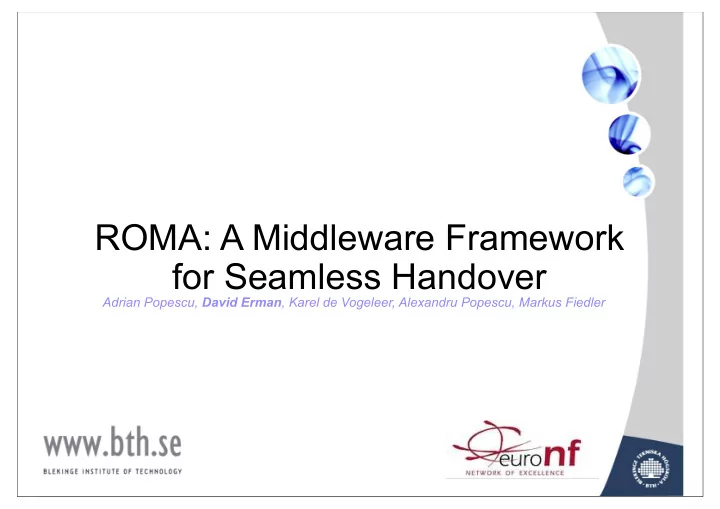

ROMA: A Middleware Framework for Seamless Handover Adrian Popescu, David Erman , Karel de Vogeleer, Alexandru Popescu, Markus Fiedler
Situation today • Device heterogeneity • Access network heterogeneity • Application heterogeneity • Trend towards complete connectivity everywhere • Solutions? • IP: “One protocol to rule them all, one protocol to find them, one protocol to bring them all and in the socket bind them” • Middlewares to abstract the complexities of connectivity
A very simple middleware abstraction APIs • Two main tasks: • Export API for applications Middleware • Interface one or more communication networks using protocols Communication • But the devil is in the details Network
But, where did the hourglass go?
NAT made it fat! • What about the top of the hourglass? • Also got fatter • More applications • More Middlewares! • The hourglass is getting top- heavy?
Handling complexity? • Current trend in MW seems to be the classical CS solution to every problem: • “Another level of indirection/abstraction.” • Meta-middlewares, a.k.a. abstract platforms, are appearing • SMILE – Simple Middleware-independent Layer • ROMA – A Middleware Framework for Robust Mobile Applications • MDA – Model-Driven Architecture • The end result of this? • We have a set of abstractions that abstract abstractions, which in turn abstract other abstractions, that abstract… • It’s easier to view MW networking as composed of functional blocks , rather than a layered architecture,
Functional view App App App Middleware Service Service Service Substrate Access Access Access
The ROMA Architecture
The Architecture in Short • Application-layer architecture for abstracting network connectivity(ies) • Originally intended for performance studies of P2P overlays • Extended to multi-interface handover • Manages multiple interfaces and applications • Very simple API for application developers • Fairly simple API for interfacing (shimming) underlying transport technologies
Goals and requirements • Goal: Develop testbed for development, testing, evaluation and performance analysis of different solutions for user-centric mobility • ROMA Middleware is the software representation of this testbed • Requirements: • Minimal changes to existing applications • Support multiple platforms • Hide implementation style (i.e., local, client–server & P2P) • Provide network-agnostic transport enabler
The ROMA Architecture Overlays User QoE QoS Node Mobility Modeling socket Control Management Routing Positioning & Prediction interface KBR API Middleware Underlay API Unstructured P2P Structured P2P Underlays Handover UDP/IP UMTS WIMAX WLAN
Overlays and Underlays • An Overlay provides an application-level routed and controlled network over another network • An Underlay is an abstraction of a transport substrate • A substrate is any network that can provide a packet transport function • Other overlays • “Normal” IP
API Design • ROMA consists of two distinct APIs • “Upper” API based on the Key-Based Routing (KBR) API by Dabek, et al. • Provides 160-bit addressing scheme and small set of routing primitives • “Lower” API to abstract underlays • Shim layers for each underlay • Main challenges: • Address translations • Shim implementations
Current implementation status • Basic forwarding implemented • IP shim • Asynchronous event handling • Linux epoll() -> boost asio library • Open issues • Kernel-level IF switcher (for handover) • Flow multiplexing, due to multiple IFs • ROMA middleware is app-monolithic, i.e., each application gets its own copy of ROMA.
What next? • Implement vertical HO and compare to existing tunneling solution developed at BTH • Deploy for large-scale tests on PlanetLab
Thank you for your time! <?>
Recommend
More recommend